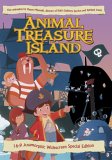| Reviews & Columns |
|
Reviews DVD TV on DVD Blu-ray 4K UHD International DVDs In Theaters Reviews by Studio Video Games Features Collector Series DVDs Easter Egg Database Interviews DVD Talk Radio Feature Articles Columns Anime Talk DVD Savant Horror DVDs The M.O.D. Squad Art House HD Talk Silent DVD
|
DVD Talk Forum |
|
|
| Resources |
|
DVD Price Search Customer Service #'s RCE Info Links |
|
Columns
|
|
|
Animal Treasure Island
The film - a Toei 20th Anniversary Production - is a singularly free adaptation of Robert L. Stevenson's famous Treasure Island, though it gets off to a good start as a mysterious pirate (a cat with requisite peg leg) visits the run-down inn where Jim Hawkins (voiced in the Japanese version by Minori Matsushima), Jim's young infant brother Baboo and friend Glan (a mouse wearing thick eyeglasses, Eiko Masuyama) yearn for adventure on the high seas. The pirate entrusts a mysterious box to Jim's care, which he later learns contains Captain Flint's legendary map to his valuable chest of riches hidden somewhere on Treasure Island.
Jim and Glan set out in Jim's boat, actually a refitted wooden barrel with a motor attached, unaware that Baboo has sneaked aboard as well. The three are eventually captured by Long John Silver (Daiei, later Toei tough-guy Asao Koike), a snarling pig, and the crew of Silver's ship, the Pork Saute: walrus Otto (Kosei Tomita) and various wolves, monkeys, and hippos. Joined later by pirate Flint's granddaughter, Kathy (Soko Tenchi), the band make their way toward Treasure Island.
In adapting Stevenson's story, screenwriters Kei Iijima and director Ikeda err not so much in turning everyone save Jim, Kathy, and Baboo into anthropomorphic animals, but rather by not adhering more closely to the original story. Here, crafty Long John Silver inexplicably becomes a very minor character, a mere blustery pirate, and the unique, compelling relationship between Silver and Jim, the very soul of the book and emphasized in other film versions, is completely absent here.
Worse, the film digresses into odd scenes of misplaced comedy that usually stop the story dead in its tracks. The screenwriters must have been fans of Hollywood comedies: One long scene has Jim trying to poison his captors by cooking them inedible objects like shoes and a baseball hidden beneath tempura batter, but then is forced to eat the ghastly meal himself once discovered. The same thing happens more or less in Laurel and Hardy's Saps at Sea (1940), while a tangential visit to "Pirate Island" seems inspired by the outrageous pirates' cove visited by Bob Hope in The Princess and the Pirate (1944).
Long John Silver may be a pig, but he's no Porco Rosso, and there's little in the animation to hint that Japan's greatest anime force since Osamu Tezuka was on the cusp of bigger and better things. Visually Animal Treasure Island is rather flat, with notably undistinguished character design. Still, the movie comes to life here and there, especially during a yellow-tinted pirate montage/song that looks like a something out of a Kinji Fukasaku yakuza thriller.
Indeed, the only standout at all in the production is Naozumi Yamamoto's (Gate of Flesh, Hoodlum Soldier, Yoji Yamada's Tora-san series) score, which has several good children's songs and a memorable title theme. (Too memorable perhaps - this reviewer can't get it out of his head!)
Video & Audio
As hum-drum as Animal Treasure Island is, it's still great to see it in all its glory, in a 16:9 anamorphic transfer preserving its original Toeiscope (2.35:1) aspect ratio. The "blocking" of the characters is often conventional, but the backgrounds make good use of the format. Japanese feature animation from this period is relatively rare in the west, especially in widescreen transfers in their original Japanese. There's virtually zero age-related wear, and the colors are true throughout. (The filmmakers did opt for a peculiarly sickly green hue for the ocean; they must have got a bargain on green paint.) The 2.0 mono tracks for both the English and Japanese audio are reasonably clear and free of distortion, with the Japanese track especially clean. The subtitles are pretty different from the English soundtrack and kudos to Discotek for translating all the main title credits.
Extra Features
Extras are limited to two Japanese trailers, 16:9 and subtitled: "You can see this cool movie during spring break!" says the latter, which features original animation created just for the trailer. Also included is a 4:3 letterboxed trailer for Taro the Dragon Boy (Tatsu no ko Taro, 1979).
Parting Thoughts
Animal Treasure Island is a good film for very small, easily-pleased kids and anime completists interested in early Japanese feature animation. More general audiences, however, will find it aimless and undistinguished, especially when it gets away from its own story.
Stuart Galbraith IV is a Kyoto-based film historian whose work includes The Emperor and the Wolf - The Lives and Films of Akira Kurosawa and Toshiro Mifune and Taschen's forthcoming Cinema Nippon. Visit Stuart's Cine Blogarama here.
|
| Popular Reviews |
| Sponsored Links |
|
|
| Sponsored Links |
|
|
| Release List | Reviews | Shop | Newsletter | Forum | DVD Giveaways | Blu-Ray | Advertise |
|
Copyright 2024 DVDTalk.com All Rights Reserved. Legal Info, Privacy Policy, Terms of Use,
Manage Preferences,
Your Privacy Choices | |||||||














